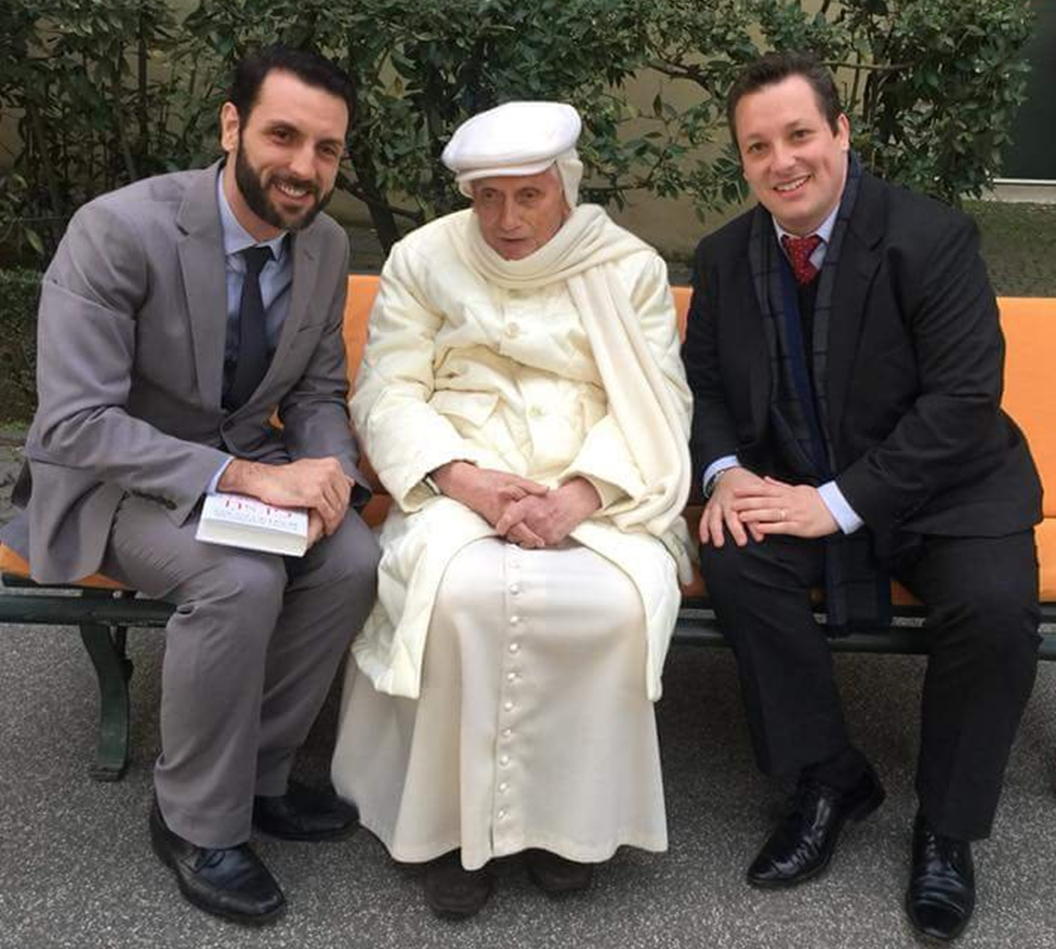 Just a bit of chronological context: 'INTRODUCTION TO CHRISTIANITY', which became an almost-instant theological classic, was published one year before Jorge Bergoglio was ordained a priest.
Just a bit of chronological context: 'INTRODUCTION TO CHRISTIANITY', which became an almost-instant theological classic, was published one year before Jorge Bergoglio was ordained a priest.
ALWAYS AND EVER OUR MOST BELOVED BENEDICTUS XVI


First photo of B16 I've seen this year, thanks to Beatrice, whose site unearthed it from the Brazilian website Fratres in unum, of a traditionalist community.
It is featured as the site's 'Photo of the Week' and is captioned: "Vatican, February 16, 2018: A friend and great collaborator of FratresInUnum. com, Felipe
Menegat, Knight of the Order of the Holy Sepulchre, at right, met with Emeritus Pope Benedict XVI."
I have chosen not to post anything so far on a minor brouhaha in the past week in which a German regional newspaper in Bavaria quotes Mons. Georg Ratzinger as saying that his brother is afflicted with a neurologic condition that is worsening and could end his life at any time sooner or later. The Vatican Press Office took it upon itself to issue a denial. It has not been determined whether the pope's brother did make the statements at all.
Benedict XVI needs our prayers, and I do not doubt that those who love and admire him do not fail to pray for him everyday. I must admit I did not think that his physical condition would deteriorate so rapidly in the past 5 years - and God forbid he should be suffering from a degenerative neurological condition!
However, those who have been mocking him because they thought his renunciation of the Papacy in 2013 was nothing but self-indulgent 'fleeing from the wolves' ought to have second thoughts now. It's hard to think charitably of them for being so uncharitable to someone who does not at all deserve to be an object of mockery, least of all from persons who collectively would not amount to anything significant compared to what Joseph Ratzinger/Benedict XVI has been in his almost 91 years of life so far!
Benedict XVI’s 'final pilgrimage Home'
by JAMES DAY

February 21, 2018
Every so often we’re witness to a splurge of commentary about Pope Emeritus Benedict XVI, as if the general populace is suddenly reminded that the man who resigned the Chair of Peter is in fact still alive. Most recently, reactions to a letter he sent to Massimo Franco of
Corriere della Serra, in which the 90-year-old’s phrase, “with the slow decline of my physical strength, interiorly I am on a pilgrimage Home,” were cause for great concern and consternation with little attempt to understand the real meaning.
Such language is nothing new from Benedict XVI, now five years after his announcement to vacate active ministry of the Petrine office genuinely stunned everybody. There is nothing quite like the abdication of the See of Rome. And because Benedict has kept his promise of withdrawing to a life of prayer and silence, his rare public words draw much attention.
On his 85th birthday in 2012 — the last birthday he would celebrate as Bishop of Rome — Benedict XVI said, “I am now facing the last chapter of my life and I do not know what awaits me.” This was overlooked at the time, but it is a tone not unlike that of “I am on a pilgrimage home.”
[He used similar language in his last-ever public address as Pope, from the balcony of the Apostolic Palace in Castle Gandolfo about two hours before his Pontificate officially came to an end.]
Benedict had long been on his pilgrimage home. He has long focused his attention on something the secular world has trouble fathoming—life after death, and what Catholicism refers to as the “four last things”: Death, Judgment, Hell, Heaven. Benedict’s mere enduring presence as a de facto monk speaking such rhetoric as “a pilgrimage home” and “the last chapter of life” rather laconically and matter-of-factly jolts our ears.
Each day is closer to the end, no matter how irascible that is to transhumanists and radical life extensionists. Benedict XVI’s interests are elsewhere, in fact they are otherworldly. He is now an old man comfortable with approaching death. In this way, his words resemble the late letters of Michelangelo, constantly referring to himself as an old man, feeble and often confused.
Il Divino’s final artistic obsession, the construction of new St. Peter’s, would become the site where Benedict XVI would celebrate his final public Mass 449 years later, having to be wheeled out on a mobile platform as he blessed the faithful on Ash Wednesday 2013. Ash Wednesday’s dictum during the imposition of ashes starkly echoes the Church’s reminder that all death is certain: “Remember that you are dust, and unto dust you shall return.”
It was the art and beauty of Michelangelo and others that Benedict XVI never tired of celebrating. It is those remarks often unnoticed when the fleeting talk of Benedict arises — the resignation and the state of the Church he left is almost always the focus — that can provide a meeting point for believer and nonbeliever alike, for both lapsed and practicing. How can admirers of the great works of Western culture, non-churchgoing they may be, ably discuss the magnitude of, say, Caravaggio’s “The Incredulity of Saint Thomas” without speaking with some reverence to the themes and symbols of the image?
Benedict stated it better time and again as pope, whether in Rome or around the world. In no less than Barcelona’s Sagrada Familia, perhaps the par excellence in the convergence of the secular and the holy, at the church’s dedication Mass in 2010, Benedict uttered,
“[Antoni Gaudí] accomplished one of the most important tasks of our times: overcoming the division between human consciousness and Christian consciousness, between living in this temporal world and being open to eternal life, between the beauty of things and God as beauty.”
The Catholic belief of God becoming man in Jesus Christ is the ultimate expression of beauty to the believer — and to Benedict XVI. The
via pulchritudinis, the “way of beauty” Benedict XVI often spoke about, achieved through prayer, work, art, and human relationships, not only is designed to lead one to the divine, but are in fact expressions of the way of Jesus Christ, the very way of beauty itself.
En route to Spain, Benedict was asked about faith and art. “An art that lost the root of transcendence would not be oriented to God,” he explained. “It would be a halved-art.” Benedict XVI was certainly not interested in halved-art any more than halved-truth or halved-reason.
The great logical thinker who extolled the relationship between faith and reason in his landmark Regensburg speech was also privy to the logical result of art and beauty: where one’s soul is uplifted, there the transcendent awaits, to transform the point of convergence to the new realm of conversion.
We likely will never experience another Benedict XVI again, certainly not one who turned over the keys of influence for a life of obscurity. And yet even in his seclusion he reminds us our earthly existence is both short and only part of the journey. Yet still there is time for renewal, for a new understanding of our place in the world.
“I am at the eleventh hour,” Michelangelo once panted, “and not a thought arises in me that does not have death carved within it; but God grant that I keep him waiting in suspense for a few years yet.”
“He started dying at about 40 and did it for 50 years,” art historian Howard Hibbard remarked about Michelangelo. The same could be said about Benedict XVI. He has been on a pilgrimage home his whole life.
[As we all are, or ought to be!]
[Modificato da TERESA BENEDETTA 22/02/2018 07:08]